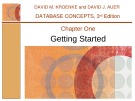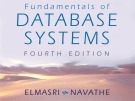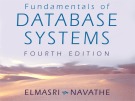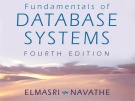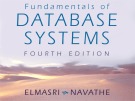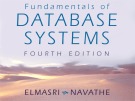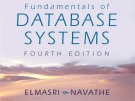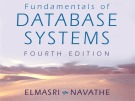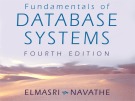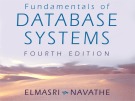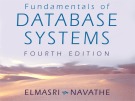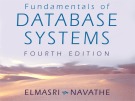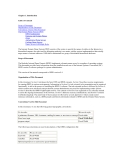
Fundamentals of database systems
-
Chapter 1 - Getting started. After completing this unit, you should be able to: Identify the purpose and scope of this book, know the potential problems with lists, understand the reasons for using a database, understand how related tables avoid the problems of lists, learn the components of database system, learn the elements of a database, learn the purpose of the database management system (DBMS), understand the functions of a database application.
 32p
32p  tangtuy17
tangtuy17
 11-07-2016
11-07-2016
 44
44
 3
3
 Download
Download
-
Chapter 7 - Database processing applications and business intelligence. In this chapter, you will learn: Understand and be able to set up Web database processing, learn the basic concepts of Extensible Markup Language (XML), learn the basic concepts of business intelligence (BI) systems, learn the basic concepts of OLAP and data mining.
 61p
61p  tangtuy17
tangtuy17
 11-07-2016
11-07-2016
 36
36
 2
2
 Download
Download
-
Chapter 1 introduction and conceptual modeling. To understand the fundamentals of database technology, however, we must start from the basics of traditional database applications. we start by defining a database, and then explaining other basic terms,...
 24p
24p  kiepnaybinhyen_04
kiepnaybinhyen_04
 15-12-2015
15-12-2015
 86
86
 5
5
 Download
Download
-
In this chapter presenting the terminology and basic concepts that will be used throughout the lecture. This chapter discusses data models and defines the concepts of schemas and instances, which are fundamental to the study of database systems, discuss the three-schema DBMS architecture, provides a user’s perspective on what a DBMS is supposed to do, describe the types of interfaces and languages that are typically provided by a DBMS,...
 33p
33p  kiepnaybinhyen_04
kiepnaybinhyen_04
 15-12-2015
15-12-2015
 74
74
 3
3
 Download
Download
-
In chapter 3, we follow the traditional approach of concentrating on the database structures and constraints during conceptual database design. The design of application programs is typically covered in software engineering courses. this chapter also present the modeling concepts of the Entity-Relationship (ER) model, which is a popular high-level conceptual data model.
 38p
38p  kiepnaybinhyen_04
kiepnaybinhyen_04
 15-12-2015
15-12-2015
 72
72
 3
3
 Download
Download
-
In this chapter, we describing features that have been proposed for semantic data models, and show how the ER model can be enhanced to include these concepts, leading to the Enhanced ER (EER) model.
 22p
22p  kiepnaybinhyen_04
kiepnaybinhyen_04
 15-12-2015
15-12-2015
 44
44
 2
2
 Download
Download
-
Chapter 4 (Part II) - Enhanced Entity-Relationship and UML modeling include contens as: Fundamental principle of modeling, basic process of modeling, add constraints - structural/ semantic,...
 29p
29p  kiepnaybinhyen_04
kiepnaybinhyen_04
 15-12-2015
15-12-2015
 75
75
 2
2
 Download
Download
-
In this chapter, The contents concentrate on describing the basic principles of the relational model of data, begin by defining the modeling concepts and notation of the relational model, discussion of relational constraints that are considered an important part of the relational model and are automatically enforced in most relational DBMSs, defines the update operations of the relational model,...
 29p
29p  kiepnaybinhyen_04
kiepnaybinhyen_04
 15-12-2015
15-12-2015
 60
60
 2
2
 Download
Download
-
Chapter 7 discusses how to design a relational database schema based on a conceptual schema design. This chapter presented a high-level view of the database design process, and in this chapter we focus on the logical database design or data model mapping step of database design. We present the procedures to create a relational schema from an Entity-Relationship (ER) or an Enhanced ER (EER) schema.
 32p
32p  kiepnaybinhyen_04
kiepnaybinhyen_04
 15-12-2015
15-12-2015
 89
89
 4
4
 Download
Download
-
In this chapter we discuss the two formal languages for the relational model: the relational algebra and the relational calculus. The main contents in this chapter include: Example database application (COMPANY), overview of the QBE language (appendix D),...
 53p
53p  kiepnaybinhyen_04
kiepnaybinhyen_04
 15-12-2015
15-12-2015
 52
52
 3
3
 Download
Download
-
Chapter 8 describes more advanced features of the SQL language standard for relational databases. In this chapter present more complex features of SQL retrieval queries, such as nested queries, joined tables, outer joins, aggregate functions, and grouping.
 71p
71p  kiepnaybinhyen_04
kiepnaybinhyen_04
 15-12-2015
15-12-2015
 61
61
 3
3
 Download
Download
-
Chapter Objectives: Specification of more general constraints via assertions, SQL facilities for defining views (virtual tables), various techniques for accessing and manipulating a database via programs in general-purpose languages (e.g., Java).
 45p
45p  kiepnaybinhyen_04
kiepnaybinhyen_04
 15-12-2015
15-12-2015
 51
51
 3
3
 Download
Download
-
Chapter 10 present functional dependencies and normalization for relational databases. This chapter includes contents: Informal design guidelines for relational databases, functional dependencies (FDs), normal forms based on primary keys, general normal form definitions (For Multiple Keys), BCNF (Boyce-Codd Normal Form).
 49p
49p  kiepnaybinhyen_04
kiepnaybinhyen_04
 15-12-2015
15-12-2015
 66
66
 3
3
 Download
Download
-
Chapter 11 present the contents: Designing a set of relations, properties of relational decompositions, algorithms for relational database schema, multivalued dependencies and fourth normal form, join dependencies and fifth normal form, inclusion dependencies, other dependencies and normal forms.
 43p
43p  kiepnaybinhyen_04
kiepnaybinhyen_04
 15-12-2015
15-12-2015
 54
54
 2
2
 Download
Download
-
Overview The Oracle server uses many memory components, background processes, and file structures for its backup and recovery mechanism. This lesson reviews the concepts presented in the Oracle9i Database Administration Fundamentals I course, with an emphasis on backup and recovery requirements. Oracle Instance An Oracle instance consists of memory areas (mainly System Global Area [SGA]) and background processes, namely PMON, SMON, DBWn, LGWR, and CKPT. An instance is created during the nomount stage of the database startup after the parameter file has been read.
 46p
46p  trinh02
trinh02
 28-01-2013
28-01-2013
 56
56
 5
5
 Download
Download
-
Introduction Table of Contents Scope of Document Organization of This Document Conventions Used in This Document The Domain Name System (DNS) DNS Fundamentals Domains and Domain Names Zones Authoritative Name Servers Caching Name Servers Name Servers in Multiple Roles The Internet Domain Name System (DNS) consists of the syntax to specify the names of entities in the Internet in a hierarchical manner, the rules used for delegating authority over names, and the system implementation that actually maps names to Internet addresses.
 75p
75p  tengteng16
tengteng16
 28-12-2011
28-12-2011
 60
60
 8
8
 Download
Download
-
Database you say—now there's a word you hear all the time! In a nutshell, a database is an electronic collection of information designed to meet a handful of needs: Databases provide one-stop shopping for all your data storage requirements. The database contains any amount of data, from the small to the huge. Databases must provide mechanisms to retrieve data quickly as applications interact with their contents. Databases allow the sharing of corporate data such that personnel data is shared amongst one's payroll, benefits, and pension systems....
 6p
6p  saviour
saviour
 24-02-2010
24-02-2010
 164
164
 26
26
 Download
Download
-
Chapter 1. Introduction Table of Contents Scope of Document Organization of This Document Conventions Used in This Document The Domain Name System (DNS) DNS Fundamentals Domains and Domain Names Zones Authoritative Name Servers Caching Name Servers Name Servers in Multiple Roles The Internet Domain Name System (DNS) consists of the syntax to specify the names of entities in the Internet in a hierarchical manner, the rules used for delegating authority over names, and the system implementation that actually maps names to Internet addresses.
 133p
133p  thachcotran
thachcotran
 04-02-2010
04-02-2010
 126
126
 10
10
 Download
Download
-
Oracle Server Technologies and the Relational Paradigm The relational paradigm is highly efficient in many respects for many types of data, but it is not appropriate for all applications. As a general rule, a relational analysis should be the first approach taken when modeling a system. Only if it proves inappropriate should one resort to nonrelational structures. Applications where the relational model has proven highly effective include virtually all Online Transaction Processing (OLTP) systems and Decision Support Systems (DSS).
 10p
10p  vongsuiphat
vongsuiphat
 04-01-2010
04-01-2010
 200
200
 64
64
 Download
Download
-
CRITICAL SKILL 1.1: Define a Database Database you say—now there's a word you hear all the time! In a nutshell, a database is an electronic collection of information designed to meet a handful of needs:
Databases provide one-stop shopping for all your data storage requirements. The database contains any amount of data, from the small to the huge.
Databases must provide mechanisms to retrieve data quickly as applications interact with their contents. 6p
6p  saviour
saviour
 08-12-2009
08-12-2009
 150
150
 38
38
 Download
Download
CHỦ ĐỀ BẠN MUỐN TÌM








